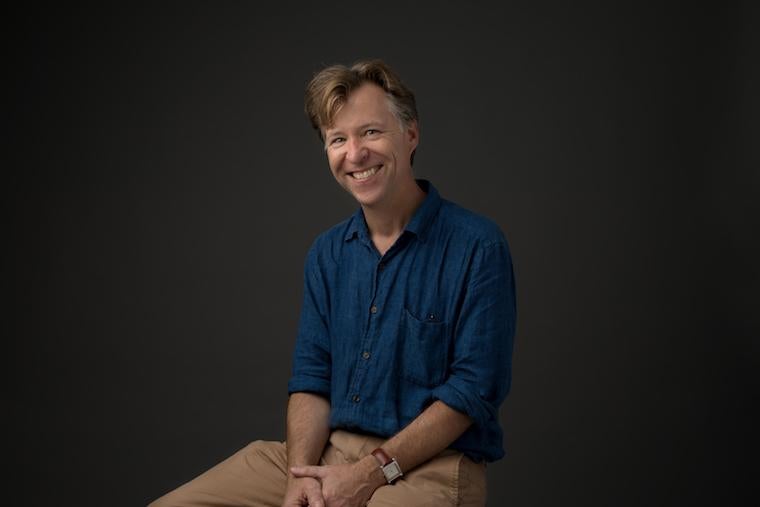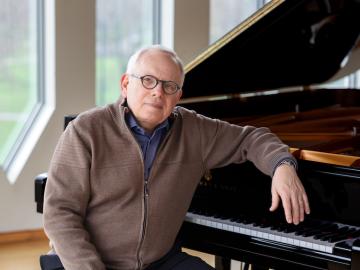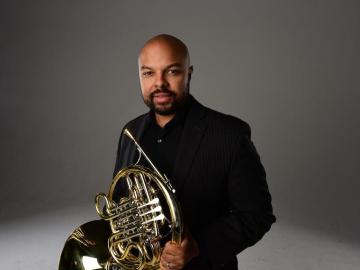Professor Erik Inglis Garners NEH Support for Medieval Art History Research
January 31, 2019
Amanda Nagy

Medieval art historian Erik Inglis is at work on a new project that examines how, in the absence of an art history discipline, people responded to earlier works of art and architecture in the Middle Ages.
When Professor of Medieval Art History Erik Inglis was researching his most recent book on the French painter Jean Fouquet, he had a revelation about the way people in the Middle Ages made sense of art produced earlier in that era.
Fouquet was a preeminent 15th-century artist famous for painting buildings such as the Notre-Dame Cathedral in Paris. Inglis explains that at the outset, there was nothing particularly remarkable about medieval artists who painted buildings—except that the cathedral was already 200 years old.
“It occurred to me that 200 years is a very long time. So, if Fouquet was painting a building that was quite old, perhaps he was interested in it historically, and its age mattered to him,” Inglis says. His book, Jean Fouquet and the Invention of France: Art and Nation after the Hundred Years War, came out in 2011, and around that time Inglis began collecting evidence to support his theory that medieval people were indeed curious about and appreciated art from before their time.
This is notable because the discipline of art history emerged in Europe just after the Middle Ages, during the Renaissance. That means that there was no genre of art historical literature in the Middle Ages. “You can’t look in a book and see what they wrote about art history,” he says.
So, to investigate what Inglis calls the medieval art historical imagination, he is researching the medieval reception of earlier art. His current research is being supported by a fellowship from the National Endowment for the Humanities (NEH), which will culminate in a book and a related course. He is on leave for the calendar year, and when he returns to the classroom in spring 2020, he plans to teach a seminar called Practicing Art History Without a License.
“I think, in a lot of ways, that’s what people in the Middle Ages were doing. They didn’t have disciplinary training, but they were still very much practicing art history.
“They were asking: who made that? When was it made? How was it made? What does it mean? They had all the questions art historians have today, but they didn’t have the disciplinary apparatus to get the answers to those questions. Sometimes their answers were remarkably accurate, and sometimes they were not, but still incredibly creative.”
One of his favorite examples involves Saint-Sernin, a 12th-century church in Toulouse, France. The church has a notable treasury of relics and different objects that were given to it over time, including an ancient Roman cameo that was credited to the circle of Charlemagne in the ninth century.
“The church also had a manuscript of Gospel extracts that was made for Charlemagne. The book has an inscription by the scribe who names himself and states that he is writing it for Charlemagne, but instead the church attributed it to St. John the Evangelist—which they said was written in his own hand. What’s interesting here is that we know Charlemagne was very important to them, yet they overlook evidence within this book because the highest praise you could give to this beautiful old book was that it was written by a saint and goes back to Biblical antiquity.”
This type of art historical imagination still exists today, even in Oberlin. The historian Geoffrey Blodgett (a 1953 graduate and professor of American history at Oberlin from 1960 to 2000) pointed out in his writings on Oberlin architecture that there are many houses erroneously associated with the Underground Railroad because they were built after the Civil War.
“Starting in the 1930s and ’40s, you see a house that looks old and beautiful, and you want to attach it to something significant that happened here. The Underground Railroad is one of the most important parts of Oberlin history. That kind of art historical imagination never goes away, but now we have a discipline to correct it.”
In Good Company
Inglis is among a number of art faculty to receive highly competitive awards. Matthew Rarey, assistant professor of art history, was awarded a 2018-2019 NEH fellowship for his book project, Insignificant Things: Assemblage, Occlusion, and the Art of Survival in the Black Atlantic; Associate Professor of Art History and East Asian Studies Bonnie Cheng received a fellowship jointly funded by the American Council of Learned Societies (ACLS) and NEH in 2006 for her project, Animating Dead Space: Medieval Chinese Tombs and the Negotiation of Cultural Traditions; and Associate Professor of Renaissance and Baroque Art History Christina Neilson received an ACLS fellowship in 2016 and an NEH fellowship in 2012.
In the studio art program, Associate Professor of Integrated Media Julia Christensen was only the second artist from Ohio to receive a Creative Capital grant in 2013 for her work with electronic waste, and she was named a Guggenheim Fellow in 2018. The prestigious fellowship is awarded to approximately 175 of 3,000 applicants each year. Professor of Studio Art and Photography Pipo Nguyen-duy received a Guggenheim Fellowship in 2011 for photography in Vietnam and Southeast Asia.
“It’s hard to find a stronger endorsement for the art department,” Inglis says. “For all of us, there are multiple benefits to this kind of support. On a personal level, to get the NEH or the Guggenheim, that means your project has been vetted at multiple levels, and many people found it interesting and significant. So when you’re getting ready to sit down at your computer and start writing for a year, it’s a sign that there’s an audience.”
Also worth noting is that fellowships provide an economic and educational benefit to the community. “There’s no question in my mind that the research it makes possible has a direct payout in the classroom,” Inglis says.
“The chance to do this research keeps us very current in our field. When we go back into the classroom, we’re giving our students absolutely the best, most current, most sophisticated, and most nuanced take on our fields.”
Tags:
You may also like…
Peter Takács—A Half-Century Celebrated
May 4, 2024
This spring marks the official conclusion of Takács’ tenure, after an incredible 48 years of teaching. Many of his former students from around the world are set to convene for a celebratory concert in Warner Concert Hall on May 12
Oberlin Presents Grammy-Winning Imani Winds in Concert
February 28, 2024
When flutist Brandon Patrick George ’08 attended Imani Winds’ Artist Recital Series performance back in 2007, he never imagined that he would one day sit in the flute chair. “Being...
David Byrd-Marrow Appointed Horn Faculty at Oberlin Conservatory
February 7, 2024
Versatile American horn player David Byrd-Marrow has been appointed to the tenure-track horn professor position at Oberlin Conservatory. He brings an expansive range of experience and repertoire to the role.


